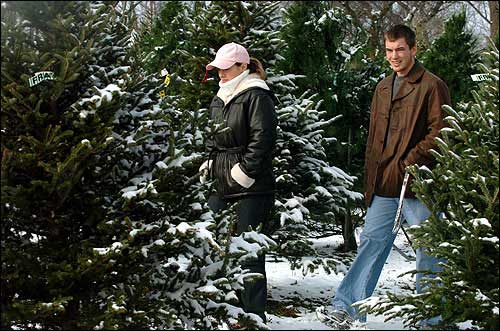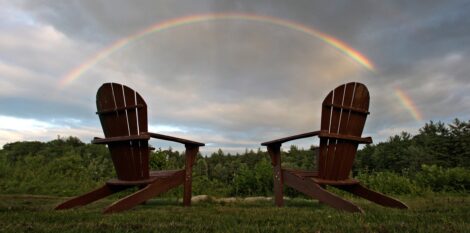O, Christmas tree
Evergreens rooted in holiday traditions
‘Tis the season to hang the mistletoe, light a fire, tune in some lovely holiday songs and gather around the tree. The holidays just wouldn’t be complete for many people without a tree to help usher in the season.
We find ourselves down in the basement, grappling to retrieve dusty boxes brimming with decorations. Each shiny ball and sparkling star holds a special memory of a Christmas past. So where did this holiday tradition start?
Although the first known decorated tree dates to 1510 in Riga, Latvia — and Queen Victoria turned the Christmas tree into a must-have item in 19th-century England — trees weren’t sold commercially in the United States until 1850.
Prior to that, families would simply choose an evergreen on their property and sharpen their ax. In 1851, the first retail Christmas tree lot in the United States was erected in New York City by a young entrepreneur named Mark Carr.
Lawrence residents Eric and Lyn Walther, owners of Strawberry Hill Christmas Tree Farm, have followed in Carr’s footsteps.
“We planted our first tree in March of 1977, and we are now celebrating our 20th year of growing and selling trees,” Eric said.
But the Walthers consider themselves to be in the entertainment business rather than the tree business. Their goal is to help set the stage for a family to create lifelong memories by making a day of coming to the farm and cutting down a hand-picked tree.
The Walther’s originally embarked in the tree business for that reason.
“We had four boys, and every year we would enjoy the ritual of getting our tree,” Eric said. “We would go to the farms in New Jersey and Maine. Eventually we began to think this might make a great retirement plan. And now, 20 years later, we are still here growing and selling trees.”

Curtis Walter and his wife Audra, of Eudora, spent part of Tuesday selecting their Christmas tree at Strawberry Hill Christmas Tree Farm west of Lawrence. Farm owners Eric and Lyn Walther planted their first tree in 1977 and are celebrating their 20th year of selling their product.
If you go to the Strawberry Hill, 794 U.S. Highway 40, the Walthers will provide the saws and a hay ride to the trees, and the Eagle Scouts will help secure your final selection onto your car. A gift shop adorned with a Christmas village is on the premises and sells cookies and hot cider.
But cutting down a real evergreen at a Christmas tree farm is not a foregone conclusion for all families. Many people feel a moral obligation — inspired by environmental concerns — to buy an artificial tree instead.
According to the University of Illinois Extension office, an artificial tree generally has a life span of about six years. Once the tree is discarded, it remains in a landfill for at least the lifespan of two generations of people.
By contrast 50 percent of all real Christmas trees purchased are recycled. Recycled trees have been used to make sand and soil erosion barriers. They are often placed in ponds to provide a natural shelter for fish and in nature to provide natural shelter for birds and other animals.

Curtis Walter spots the Christmas tree he wants to cut down and take home for the holidays. He and his wife Audra, of Eudora, searched Tuesday for the perfect tree at Strawberry Hill Christmas Tree Farm west of Lawrence.
And there are other perks to opting for a real tree.
“The benefits of a Christmas tree are that it is a renewable resource and it actually cleanses the air when it is in your home,” Eric Walther said.
In fact, an acre of Christmas trees provides the daily oxygen requirements of 18 people. This year, 73 million new Christmas trees will be planted.
The Walthers will do their part, too.
“Normally, we will plant 2,000 trees per year,” Eric said. “We use seedlings and the help of local Eagle Scouts to replenish our inventory.”




